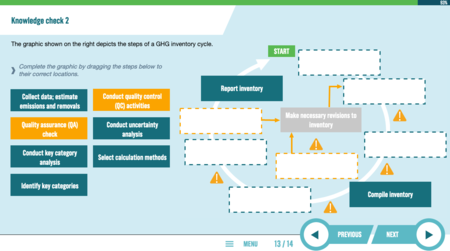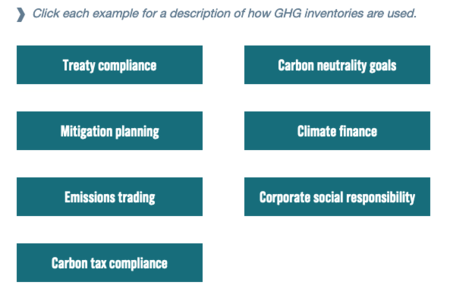Tracking emissions is a key foundation to implementing effective climate action. State and regional governments must be equipped to understand the process of emissions tracking in order to prioritise their climate actions and enhance the design of their emissions reduction strategies.
In partnership with the Greenhouse Gas Management Institute (GHGMI), an online interactive course has been created for the Climate Footprint Project to support governments in developing and mainstreaming their greenhouse gas (GHG) emissions tracking capacity.
Molly White, Education Program Director at GHGMI, has shared insights into the course’s development and how they succeeded in creating a resource that teaches not only the information needed to conduct GHG management activities but, at the same time, equipping participants with the skills to apply this information.
GHG management professionals working within subnational government are often faced with a myriad of GHG accounting tasks
While there are a multitude of GHG accounting frameworks that professionals work within, these frameworks are usually categorised as either being attributional or consequential. Attributional methods are appropriate for allocating ‘carbon budgets’ to entities and generally provide clear rules for identifying a specific set of sources and sinks and allocating ‘ownership’ or ‘responsibility’ to different entities. Consequential methods do not define a scope of responsibility concerning an entity in this way, as they are instead concerned with the impacts of specific decisions or interventions.
Most professionals become competent in practicing within one framework type. For example, a carbon offset project developer would train in the methods and programs of consequential accounting.
However, this is not the case for a practitioner working at a subnational government. In many cases, these practitioners may be responsible for managing within both of these framework types. For example, providing data to a national GHG inventory compiler, reporting subnational GHG inventory trends to a provincial program, and implementing a subsidy policy to reduce industry-wide emissions. This is no small task and increases the number of core-competencies the professional needs to have.
Subnational governments also vary extensively in their structures and their country contexts. This means that the experience of applying an accounting framework in one state or region may vary considerably from another state or region. So, how do you develop a course for this magnitude of variation that still meets the needs of an individual trainee?
As part of the Climate Footprint Project, GHGMI created an introductory course that tackles this difficult training challenge. At the most basic level, the solution applied was two-fold:
- Development of a delivery approach tailored to the target learner through a process called ‘learner characterisation’.
- Building a curriculum based on the understanding of the methods and practices behind adult learning (andragogy).
Learner characterisation
At the outset of course design, two days were spent describing and elaborating the intended course participant profile to guide the development of the curriculum.
In the case of the Climate Footprint Project, this involved characterising professionals in four of the project states (who had started their technical assistance by the time of course design) - Baja California, Jalisco, Yucatán, and Pernambuco - to develop a clearer picture of the “typical” learner-profile in the course. Traits such as educational background, employment, career achievement, entry point(s) to GHG management, language fluencies, IT access, demographics, and previous training of the target learner group were considered.
It was envisioned that the target learner would be government staff balancing the training alongside their existing professional commitments, and therefore being able to login to an online course and proceed with course work anytime, anywhere was an important factor. The curriculum also needed to be developed in the prominent languages used within the project states - Spanish, English and Brazilian Portuguese.
Applying the principles of andragogy
The course curriculum considered what learners needed to know, what their readiness and problem-orientation were, and what their likely intrinsic motivation was for taking the course.
The application of these principles starts by defining the meta-learning objectives for the entire course and then defining a sub-set of learning objectives for each individual lesson. This ensured that the content of the curriculum was developed around what the learners needed to know following completion of the course.
Adults learn through doing, even if they make mistakes. So, interactive elements were developed to compliment the learning objectives and allow for “making mistakes”, e.g. self-check knowledge checks.

The curriculum topics were organised in a way that learners would likely encounter them in the real world. Specifically, aligning with how subnational government professionals would need to make climate or GHG management decisions within one or more GHG accounting frameworks. This sequencing of content is important to being able to make the training more intuitive and of immediate use for the target learner group. Mock case study exercises were also included at the end of key lessons, to provide continuity of real-world applied concepts from one lesson to the next.
Finally, the target learner’s likely intrinsic motivation was aligned with external motivational-drivers – an element that GHGMI consider to be one of the most distinguishing attributes of a capacity development training that is successful and gets used. For this course, drivers were created within the delivery approach. These implementation activities were planned during course development and executed after course completion. These external drivers included an intentional application and training period, imposing course completion deadlines, encouraging peer-to-peer networking through online forums, and issuing certificates or credentials for those that achieved success.

The course was taken by 50 learners in the last year, funded through the Climate Footprint Project. They joined from 27 state and regional governments from across Brazil, Colombia, India, Indonesia, Mexico, Peru and South Africa. The course was aimed at project managers, sector leads and inventory compilers and there was almost even gender representation amongst the participants.
“I recommend this course to anyone who is a beginner in the development of a GHG inventory for a subnational government. The course has helped me to better understand the entire process of inventory development, the importance of ensuring good quality data, plugging data gaps and doing the estimations. I am now confident in the work that I do and will now contribute better in my team.”
“I recommend this course to anyone who is a beginner in the development of a GHG inventory for a subnational government. The course has helped me to better understand the entire process of inventory development, the importance of ensuring good quality data, plugging data gaps and doing the estimations. I am now confident in the work that I do and will now contribute better in my team.”
As the Climate Footprint Project continues to move the needle across subnational climate action, this online course will be a relied-upon resource for training.
Interested in learning more about this course? Basics of Subnational GHG Accounting is open for enrolment. And, stay tuned for the next Climate Footprint Project/Under2 Coalition training-period, the nomination and application process will begin in the fall of 2021.